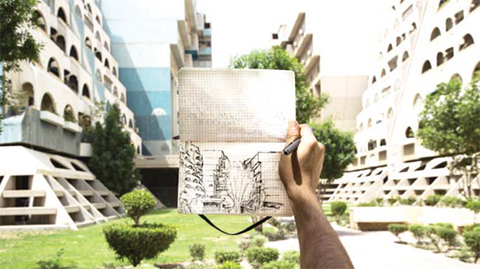 Sketch by Ali Al-Yousifi
Sketch by Ali Al-YousifiThe architectural landscape in Kuwait is renewing constantly. Old buildings are disappearing, replaced by skyscrapers and high-rises. Meanwhile, the facades of some old buildings are covered by modern claddings for the sake of beautification without repairing and restoring the interiors, just like temporary cosmetic surgery, the impact of which soon fades away. Change can be positive in architecture if construction is modern and environmentally friendly in line with the necessities of building more secure and sophisticated structures. Some groups in Kuwait are seeking to preserve old buildings, fully aware that not every old structure has an historical value.
In 2013, architect Hamad Al- Khulaifi, who holds an MA in Urban Design from Miami University, took a different path by organizing monthly architectural gatherings to help raise awareness and develop more understanding of the medium by drawing. “Drawing Kuwait” targets professionals and those interested in architecture and pushes them to continue developing their skills in drawing as well as studying buildings built in different areas of the country. “Our goal is learning about architecture in an indirect way and expanding knowledge of the architects about their field. After we draw, we critique these buildings to not to fall for the same mistakes while designing. Also, we aim to bring the architecture community together,” Khulaifi explained.
Mission of Drawing Kuwait
The first Drawing Kuwait event was at the Sawaber residential complex in Kuwait City. The construction of the complex, made up of 33 buildings and 528 apartments, ended in 1980. “We are now thinking to gather at the same place to draw it before it is demolished. Although we plan our gatherings in advance, sometimes we decide to go with no specific plan to study a place as soon as we know that it will disappear. Take Bayt Lothan for instance. We organized a drawing gathering there after it was announced that it’s going to be razed,” he added.
After the gatherings became popular through social media, Hamad decided to find partners who shared the same concerns and goals to help him in his mission. This led to architect Fatima Al-Alawi from the Kuwait Institute for Scientific Research (KISR) joining Drawing Kuwait. “The gathering is facing a problem. It seems that people come out of interest more than specialization. We urge the presence of specialists to achieve greater benefits in term of exchanging experiences and studying architectural forms to find drawbacks and advantages. In addition, we want to introduce the importance of understanding architecture to our community,” Alawi said.
“My role as a partner focuses on everything related to writing articles and descriptions that accompany the sketches and publishing through social media,” she added.
Drawing Kuwait’s current season is likely to focus on Shaheed Park, Imam Al- Sadiq Mosque, Kuwait Towers, Kuwait University and the water towers. “As you see, we don’t only focus on old buildings. So far, 18 gatherings have been organized since 2013. Our gatherings have been supported by the National Council for Culture, Art and Letters (NCCAL), the American Institute for Architecture Students - Kuwait University (AIAS) and the Kuwait Architecture Students Association (KASA),” Khulaifi said. “We have hosted a number of experienced architects and artists such as artist Zahra Al-Mahdi and architects Waleed Shaalan, Ricardo Camacho, Muhannad Al- Baqshi and Sulaiman Al-Bader. Drawing Kuwait recently filed its nomination for the Kuwait First Award for Excellence presented by the Ministry of Youth,” Khulaifi revealed.
“I hope in the future we take advantage of existing designs in other countries in addition to creating an archive of all the sketches drawn online. We still have a lot to do and a lot we want to change. We come up against property owners who have emerged from a society that does not care about the preservation of architectural heritage. The government also agrees to build badly designed buildings without taking into account the urban spaces around them,” rued Khulaifi. “But we are optimistic. Everything in this country is evolving - people in the past, for example, did not have an awareness of the health aspects of food or fashion, but now the situation is different. Architecture will take time to evolve after policy changes Kuwait. We are willing to work with all parties to provide all our experiences in order to counter the visual pollution in this country,” he concluded
By Athoob Al-Shuaibi










